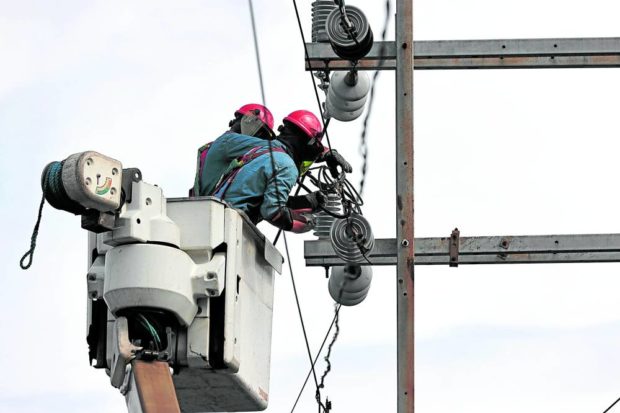MANILA, Philippines — The Energy Regulatory Commission (ERC) will look into the red and yellow alerts issued on Monday after several power plants in the Luzon grid shut down or operated at reduced capacity, thus threatening the power supply in Luzon.
In an advisory, the ERC said it would verify all the reports submitted by the National Grid Corporation of the Philippines (NGCP) and generating companies, “including the actions done to get it back online.”
“The ERC will look into the cause of the tripping and the actions taken by the NGCP to repair the subject line, including the reasons why the generating units were not able to get back online with the restoration of the transmission line,” the advisory said.
Insufficient supply
The NGCP, the grid operator, issued a yellow alert between 9 a.m. and 1 p.m. on Monday. The warning level was elevated to red alert from 1 p.m. to 4 p.m. after the NGCP anticipated that demand would outstrip available generating capacity. It was lifted at 8:01 p.m.
A yellow alert is raised when power reserves fall below the ideal levels while a red alert is declared due to an insufficient supply of electricity, which may result in rotating power interruptions.
Seven power plants with a total capacity of 3,401 megawatts went offline while three others with a total of 226 MW were operating at reduced or derated capacities, the ERC noted, citing the NGCP’s report.
Four of the power plants, namely Sual Units 1 and 2 (647 MW each) and Masinloc Units 2 and 3 (344 MW and 335 MW, respectively), were on outage following the tripping of Bolo-Nagsaag 500 kilovolt Transmission Lines 1 and 2 on Sept. 11.
Three others, Calaca Unit 2 (300 MW), Dinginin Unit 1 (668), and Quezon power plant (460 MW), have been on unscheduled shutdown prior to the tripping of the said transmission facilities.
Meanwhile, Masinloc Unit 1 (190 MW), GMEC Unit 2 (31 MW), and SLTEC Unit 2 (5 MW) were derated.
This resulted in power interruptions in the provinces of Nueva Ecija, Aurora, Pampanga, and Zambales in Central Luzon.
The Department of Energy (DOE) said on Monday that it was verifying the cause of the “simultaneous forced outages” and assured the public that there was no fuel supply constraint.
“A team from the DOE will conduct actual physical spot checks and validate the condition of the transmission lines and the affected power plants,” said Energy Secretary Raphael Lotilla in a statement earlier.
Simultaneous shutdown
On Tuesday, senators took to task officials of the DOE and the ERC for their failure to avert the power outages in several parts of Luzon.
Sen. Risa Hontiveros said Lotilla and the ERC should be “more integrated and more decisive” in addressing the immediate concerns of the energy sector, such as the control of a few groups over the generation, transmission and distribution of electricity in the country.
“The lack of solutions to the problem regarding power supply is very alarming because we know that besides blackouts, it has also caused power rate hikes,” Hontiveros said in a statement.
Senate Majority Leader Joel Villanueva said the government should investigate the real cause of the sudden brownouts and the simultaneous shutdown of the power plants supplying Luzon with electricity.
He recalled that the DOE had assured the Senate energy committee during its hearing on Sept. 6 that the supply of power in Luzon was enough until next month.
“We expect the DOE to lay out its plans to root out and solve this problem. Definitely, this issue will be brought up during the budget deliberations on DOE’s 2023 budget,” he told the Inquirer.
Sen. Juan Edgardo Angara noted that the country had grappled with a similar situation in the 1990s.
“We should see how to incentivize and speed up the building of new power plants,” Angara said.
RELATED STORY
Brownouts hit Luzon as 7 power plants shut down
